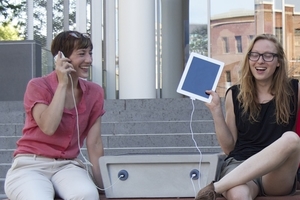In Boston Solar-Powered Benches Called ‘Soofas’ Charge Phones
Our energy consumption needs a serious intervention. Using non-renewable products for energy production has huge drawbacks, including limited supplies, pollution, the dependence on foreign oil and coal supplies and the sky-rocketing price increases that goes along with that.
But the solar power industry has been pushing out innovations right, left and centre, some of which could have the potential to make serious positive impact on our energy systems. Pushing the cause forward, a star-up called Changing Environments has created benches dubbed as “Soofas”. They are solar-powered benches which disseminate location-based information such as noise, temperature, and air pollution levels through a website and yes, the best part, they charge your mobile phones.
 The hi-tech benches were first introduced in 2013, and has since been constantly upgraded to provide a larger seating area and the ability to plug in two phones simultaneously via USB. The makers of Soofas were also thinking of including an inductive charging stations similar to those being deployed in Starbucks outlets through out the US. These look a lot like regular benches, except they’re equipped with big, steel-encased blocks that contain vulnerable-looking photovoltaic panels and charging points for weary-legged phone users.
The hi-tech benches were first introduced in 2013, and has since been constantly upgraded to provide a larger seating area and the ability to plug in two phones simultaneously via USB. The makers of Soofas were also thinking of including an inductive charging stations similar to those being deployed in Starbucks outlets through out the US. These look a lot like regular benches, except they’re equipped with big, steel-encased blocks that contain vulnerable-looking photovoltaic panels and charging points for weary-legged phone users.
There’s also a mishmash of Verizon-connected sensors inside, which records and transmits data about air quality and noise levels, as well as information on how much energy is being generated. So far, four Soofas have been placed in different parts of Boston and several more will be added in the coming weeks.
The creators are planning to make all the Soofa data publicly available once it improves its real-time data map. The group is also hoping to speed up production and develop more advanced versions of the bench. The startup has yet to determine its pricing. “Soofa is the first step into smart urban furniture,” Changing Environments CEO and Soofa co-inventor Sandra Richter says in a statement. “The possibilities to update the city for the mobile generation are endless and long overdue.”
Soofas have a huge potential and can be used as motion sensors on the Soofas to collect data for companies, allowing them to better gauge how many passersby are in the area.


There are no comments
Add yours